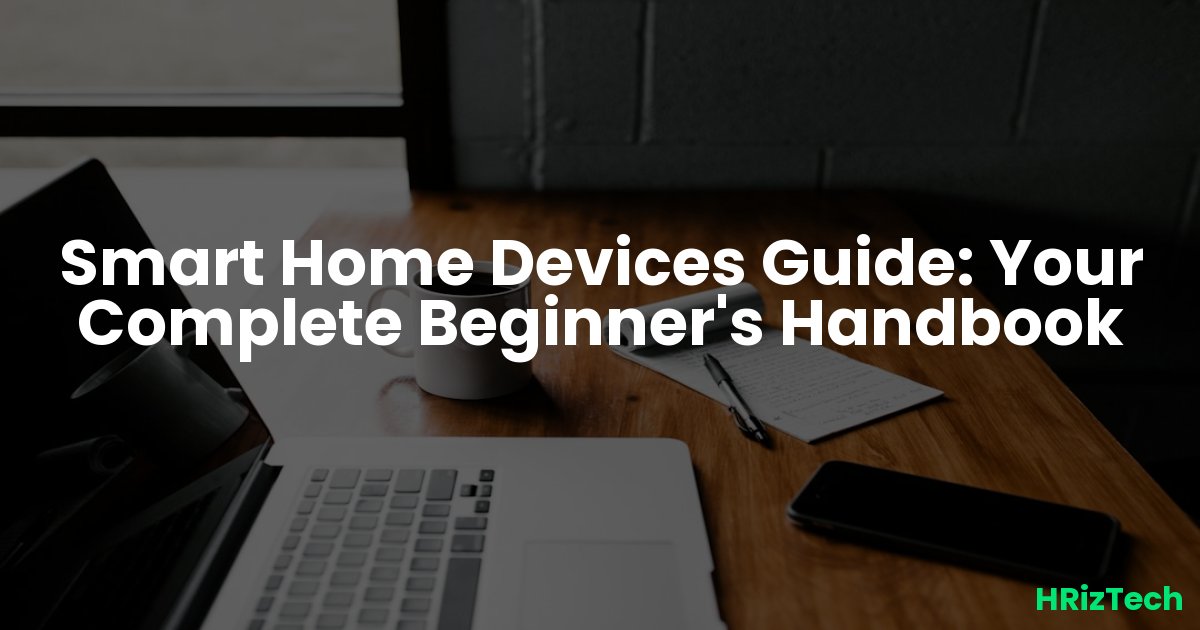Smart Home Devices Guide: Your Complete Beginner's Handbook

Smart Home Devices Guide: Your Complete Beginner's Handbook
Ever walked into your house and wished you could control the lights or the thermostat without lifting a finger? That’s the promise of smart home technology, and this Smart Home Devices Guide will show you how to make it a reality.
What are Smart Home Devices and Why Should You Care?
Smart home devices are basically everyday appliances and gadgets connected to the internet, allowing you to control them remotely using your smartphone, tablet, or voice assistant. Think smart lights, smart thermostats, smart speakers, and even smart refrigerators! But why bother? Because they offer incredible convenience, energy savings, and enhanced security.
Convenience Redefined
Imagine preheating your oven on your commute home, or dimming the lights to create the perfect ambiance with a simple voice command. That’s the power of a smart home! It automates tasks, saves you time, and makes life just a little bit easier.
Energy Efficiency
Smart thermostats learn your habits and adjust the temperature accordingly, saving you money on your energy bills. Smart lights can be scheduled to turn off when you’re not home, further reducing energy waste. These small changes add up to big savings over time.
Enhanced Security
Smart security systems, including smart door locks and security cameras, offer peace of mind knowing your home is protected, even when you’re away. Many systems send alerts to your phone if anything unusual happens, allowing you to take action immediately.
Choosing the Right Smart Home Devices: Where Do I Start?
The world of smart home devices can feel overwhelming, but it doesn’t have to be. Start small and focus on the areas that matter most to you. Do you want to improve your home security? Boost energy efficiency? Or simply add some convenience to your daily routine?
Prioritizing Your Needs
Think about your priorities. Do you spend a lot of time away from home? A smart security system might be your top priority. Are you conscious about energy consumption? A smart thermostat is a great investment. By focusing on your needs, you can avoid buying unnecessary gadgets.
Compatibility is Key
Ensure compatibility before buying anything! Many smart home devices work with specific platforms like Google Home, Amazon Alexa, or Apple HomeKit. Choosing a platform and sticking to it will make your smart home setup much easier to manage. A 2025 Gartner report predicts increased focus on cross-platform compatibility, making integration simpler in the future.
Setting Up Your Smart Home: A Step-by-Step Guide
- Choose a smart home platform: Select either Google Home, Amazon Alexa, Apple HomeKit, or another platform that suits your needs and existing devices.
- Start with a core device: Begin with a smart speaker (like a Google Nest or Amazon Echo) as your central control hub.
- Add devices gradually: Don't try to automate everything at once. Start with one or two devices and expand your system as you become more comfortable.
- Download the apps: Download the necessary apps for each device and platform to manage your smart home effectively.
- Customize your settings: Personalize your smart home settings to reflect your preferences and daily routines.
Smart Home Security: Protecting Your Digital Fortress
As we integrate more devices into our homes, cybersecurity becomes paramount. A strong password for your Wi-Fi network and each individual device is crucial. Regularly update your devices’ firmware to patch security vulnerabilities. Consider using a VPN for added security, especially if you control your smart home remotely.
Future Trends in Smart Home Security
Expect to see more advanced AI-powered security features in 2025, including better threat detection and proactive security measures. These advancements will require robust cybersecurity protocols to prevent malicious attacks. This is highlighted in recent reports from leading cybersecurity firms focusing on IoT device vulnerabilities.
How Do I Choose Between Smart Assistants? Which is Right for Me?
The choice between Google Assistant, Amazon Alexa, and Apple HomeKit often comes down to personal preference and existing tech ecosystems. Google Assistant boasts strong integration with Android devices, while Alexa has a massive library of skills. Apple HomeKit excels in seamless integration within the Apple ecosystem.
Exploring Different Smart Assistant Capabilities
Each assistant offers unique strengths and weaknesses. Consider factors such as voice recognition accuracy, device compatibility, and the range of smart home devices each supports. Researching reviews and comparing features can help you make an informed decision.
Smart Home Devices Guide: Conclusion
Building a smart home is an exciting journey, offering convenience, energy savings, and enhanced security. This Smart Home Devices Guide provides a solid foundation for getting started. Remember to prioritize your needs, choose compatible devices, and prioritize security. This Smart Home Devices Guide is just the beginning – explore and discover the endless possibilities of a connected home!
What’s your biggest concern about adopting smart home technology? Let me know in the comments!
Comments
No comments yet. Be the first to comment!